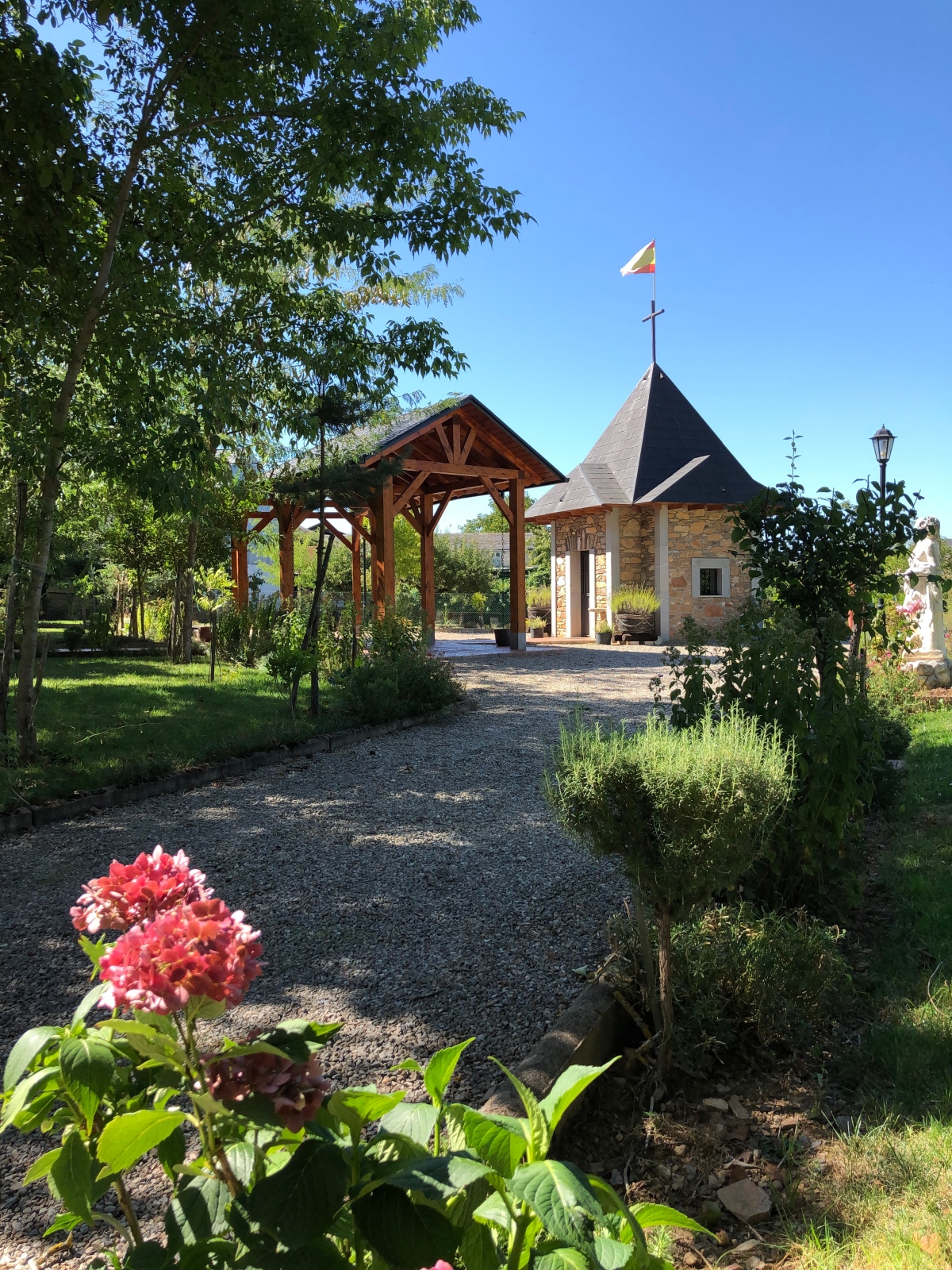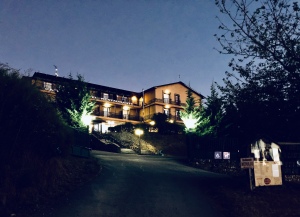Days walking the Camino, any of the many pathways, frequently hold surprises. These may be new sightings, places or visions that we hadn’t expected. On my first Camino one such was the Mexican indigenous man, a pilgrim like all of us, who carried and rhythmically tapped on a large round drum. Surprises might come in the form of people we meet and with whom we form new friendships. Some bonds end after we all arrive in Santiago, and others last beyond this shared experience. I had some of both on the Camino Frances. Or it may come as a surprise that when you expect to be walking with other peregrinos, there’s very few, and our encounters on the way are infrequent and brief. That was my experience on the Portugues, particularly the first 12 days from Lisbon to Porto, after which it felt like a whole new Camino, a surprise as well.
My first day on the Invierno had some surprises as well. Like any departure or crossing of a good sized city – Ponferrada has a population of 70,000 – it’s both scenic and sad. It starts with scenic. My day began at 7am with a requisite “cafe con leche“ (I love it so much Nancy and I now make it at home each morning) and a short walk through two central plazas – now empty and silent, compared to their vibrancy the night before – and past the “Castillo de los Templarios” – the iconic Templar’s’ fortress, established in the 12th century. In the tradition of the Camino, the Knights Templar here served to secure and finance the long and hazardous journeys of medieval pilgrims. I imagine it was the Templars that also directed pilgrims, in the winter months, to avoid one route because of impassable mountain conditions and follow an alternative path, the Invierno. It’s the one I’m doing now, so at the sign, I turn left rather than right, and now I’m on my way.



Next come sad surprises, but not atypical of any city. There’s some soulless, but functional apartment buildings, interspersed with tidy private homes. After crossing a bridge over the Rio Sil, my way turns right and soon narrows to a one lane road past an abandoned and vandalized factory building. To my right is the river, the burbling of which soothes my first day jitters. Soon there’s one more commercial building, a warehouse, and then the pavement ends and I’m on the Camino as you might envision it, a dirt path. Gradually it ascends, and soon any vestige of the city is left behind.


The next surprise of sorts is the steady and unrelenting climb of the day. Around each turn, despite my hope for flatness, I see that it continues to ascend, though just gradually at first. One by one I walk through villages (hamlets might be the more appropriate word) where few people are about and most structures are beautifully decorated with boxes or pots of flowers suspended from 2nd floor (they say 1st floor here) balconies hanging precariously over the narrow street. There’s always a church and a small plaza – it’s where life takes place in any Spanish community – and then I’m out of the village again, soon to enter another one. This goes one for a while, with the path sometimes cut through the earth, and other times appearing to go through enclosed tunnels of trees and dense bushes. In Borrenes, a village, I stop for coffee and to replenish my water. The innkeeper asks where I’m headed. It’s mid afternoon and I suspect he wants me to take one of his rooms. I tell him I’m “reservada” in Orellan. He sucks in his breath, and shakes his head, implying I’m making a big mistake. He says it’s “mucho kilometros y mucho calor” (long and hot) and uses his hand to say it’s all uphill. I wave him off and say “gracias y chao.” But I’m wondering now whether I did the right thing when I planned my day from the comfort of my desk six weeks ago.



To keep it short, the innkeeper in Borrenes was right, and I was wrong. But if I’m anything at all, it’s stubborn. And so I climb for the next three and a half hours. Steady, unrelenting, only up, never down, sometimes on a dirt path within yards of a paved road and sometimes on the road itself (it’s easier, especially since I encountered only a handful of cars going either way).
Finally, there’s Orellan, and just in time at 8pm as the sun is setting. I need to take off this pack, get the weight off my feet, take a shower, maybe eat (it’s not essential now), and then sleep. Weeks ago I booked a room at a “Casa Rural,” a bed & breakfast. This tiny mountain hamlet offers nothing else, three Casas. The one I picked from the web is clearly a bit strange, decorated with gnomes, toadstools and three small structures that gnomes or Hobbits might inhabit. As i approach, a sign across the gate reads “Cerrado.” Thanks to my Spanish lessons I know this say “closed.” Say what! I see movement in the backyard and yell “Hola Senor.” No Hobbit, the person that approaches is in his late 50s, barefoot with distinct purple-painted toenails. His eyes are dark with kohl shadows around his eyelids. And then there’s the hair, partly gray, partly black Rasta-style dreadlocks extending beyond his waist. I tell him I have a reservation which he acknowledges a bit reluctantly. Then he invites me through the gate and takes me to a Hobbit house, and as I see the bed and envision my rest, at last, he utters some unrecognizable Spanish, except I understand “no agua.” You’re joking, you clown, I thought, surely you DO have water, but he repeats himself three times, he definitely has no water. Then he directs me further into the village, indicating that I’d find two more Casas. Disheartened, especially as it was getting late, and would be dark soon, I try my luck with both small lodging places and, while they do have “agua” they are “completo,” full.
At the second place I beg the innkeeper to make some calls to the nearest available option. Hearing him say “vale” (OK) couldn’t have sounded sweeter until he explains that it is 5 km. away (about 3 miles) and there are no taxis in Orellan. After buying a bottle of water and an ice cream cone, I set off one more time, now in the darkening of night, and along a winding dirt path called the Calle de Conventos. The blessing, though, is it’s downhill, and eventually it connects to the same highway I’d been on before, but now it too is downhill towards the village of Las Medulas, the last room in a hotel, a bed and AGUA. After 14+ hours of walking the Camino Invierno my first day finally ends.


Wow that was quite a first day. That darn internet. Hobbits, purple toe nail polish, and no agua. The good news is you did get a room. I can’t wait to hear about the next days to come.
LikeLike
Tony – Your account reminds me of one of my kids’ favorite jokes growing up. An old lady in danger from a flood, keeps refusing multiple offers of help, saying that she’s “trusting in the Lord”. Well, she finally drowns and goes to heaven where she criticizes God for not saving her. He replies, “What do you mean, I sent a police car, then a boat, then a helicopter!” Sounds like you didn’t yet have your “Camino ears” on. I bet you do next time. ¡Buen Camino! Jay
LikeLike
OMG 😮 I’m almost crying and I woulda been if I’d been walking alone! I’m hoping that’s your only 14 hour day, that everyone else has water, please…no more 3 hours plus of hills and…thank GOD for ice cream!!!
LikeLike
Oh my! What a first day! Why didn’t you flag down a tuk-tuk? Glad at least you did find lodgings and agua . . . And hopefully you shortened your ongoing route by 5k?
LikeLike
We really do live in different worlds, my friend, but you made me laugh, and for that I thank you. Best to you and Sarah. T
LikeLiked by 1 person
Oh Tony! My heart sank as I read later and later I to your trek. And I’m thirsty for you. Here is to a shorter hike tomorrow with a hearty meal and a slight downward slope. ❤️
LikeLike
What an experience! You are truly an adventurer, and thanks so much for sharing it with us. I love that you needed an ice cream in the midst of the crisis! Well done.
LikeLike
I felt your pain as I was walking to the Redfish Lake inlet on Saturday afternoon following our return from Warbonnet Basin.
LikeLike